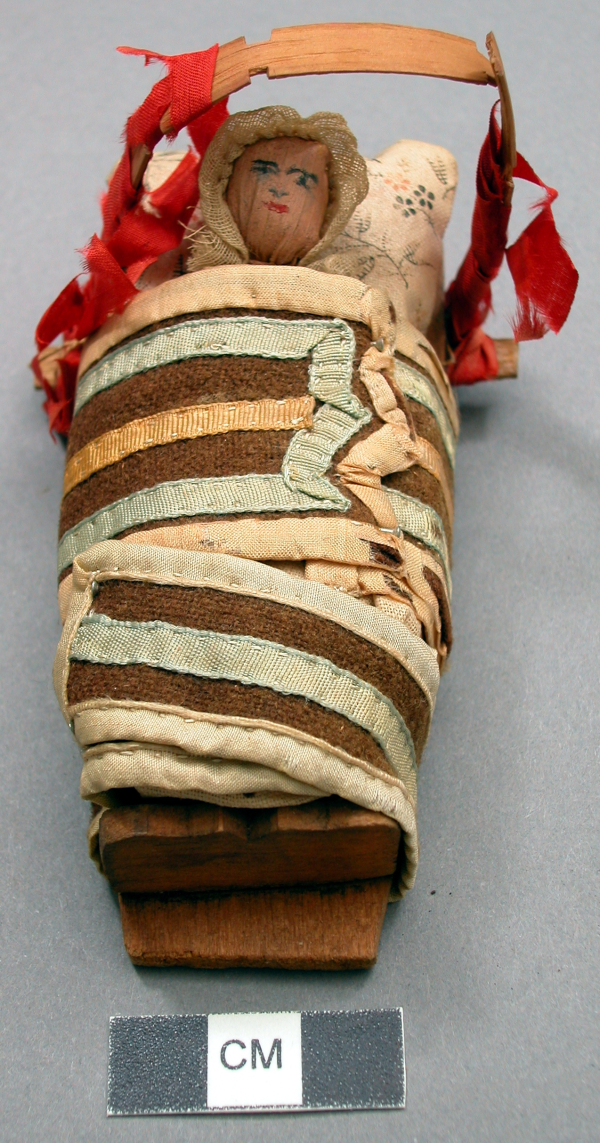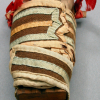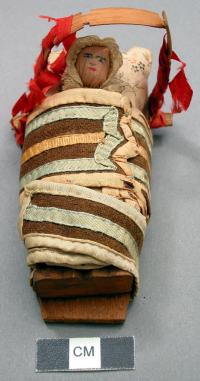child's doll in a cradleboard
child's doll in a cradleboard
child's doll in a cradleboard


This item is a doll in ribboned wrappings. The wrappings fasten the doll to the cradleboard. The doll's head is corn husk with a painted face. Notably, the face is light complected and edged with frilly lace. Red fabric strips are wrapped around the crossbar.
The Peabody Museum of Archaeology and Ethnology.
Mrs. Baird made a traditional Menominee cradleboard and a cornhusk doll.
Read More About This Relative
Wood, Fabric, Corn husk, Metal, Pigment, Lace
The artist splits the cedar wood with wedges and a mallet into a flat plank and sands it until it is smooth. Cedar wood strips are peeled from the log, split, steamed, bent and fastened to a form to dry in a curved shape. The crossbar is fastened to the cradleboard with screws, wedges, or sinew.
The artist assembles the cornhusk doll. Soak the cornhusk in warm water for at least an hour to make it soft. The corn's husk is torn into narrow strips and tied at the narrow end. The doll is turned upside down and the leaves are bent down over the knot and secured with another string. The hidden knot forms the doll's head and the string tied below the knot forms the doll's neck. Twisted or braided corn husks form the arms. Another string secures the placement of the arms through the doll's body and also forms the waist. The remaining husk below the waist is split into legs and ties form the ankles. Do not paint on the nose, eyes, and mouth. Sew the doll's dress. Trim the bonnet with lace. The ribbons are sewn onto the wrappings used to secure the doll to the cradleboard.
The blue and yellow ribbons are sewn onto a long and narrow piece of brown and rough fabric. The ends of the wrappings are cut to a wavy profile as is the foot rest of the cradleboard.
The cornhusk dolls indicate that the community will have a good harvest. The dolls do not have a face usually. The face may have been added at a later time.
The wrappings represent two realms, the physical world and the spiritual world. The rough brown fabric is the physical world. The blue ribbon and the wavy profile cut at the ends of the wrappings represent water. The footboard's wavy profile also represents the water. The yellow ribbon represents the path of the sun and its path from the physical to the spiritual. Infants are the newest arrivals to the physical world from the spiritual world and infants said to be closest to the spiritual realm. Red is spirit's colour. Like all toy's purposes, this toy reflects and reinforces these worldview teachings through play.
The original function of the cornhusk doll and cradleboard is as a toy for a child's play. The toy reflects and reinforces Indigenous worldview through play.
The Peabody Museum of Archaeology and Ethnology.
Provenance
Miss Fairchild donated this item to Peabody Museum of Archaeology and Ethnology.
The Peabody Museum of Archaeology and Ethnology.
The Peabody Museum of Archaeology and Ethnology.
Harvard University: Peabody Museum of Archaeology and Ethnology classified under : Toys
About This GRASAC Record
Artists: Mrs. Baird, Cradleboard and cornhusk doll. Currently in the Peabody Museum of Archaeology and Ethnology 16-18-10/86696.1.
May 31, 2021 (created by Sheila Wheesk)













The Peabody Museum of Archaeology and Ethnology.
 Knowledge Sharing Platform
Knowledge Sharing Platform

